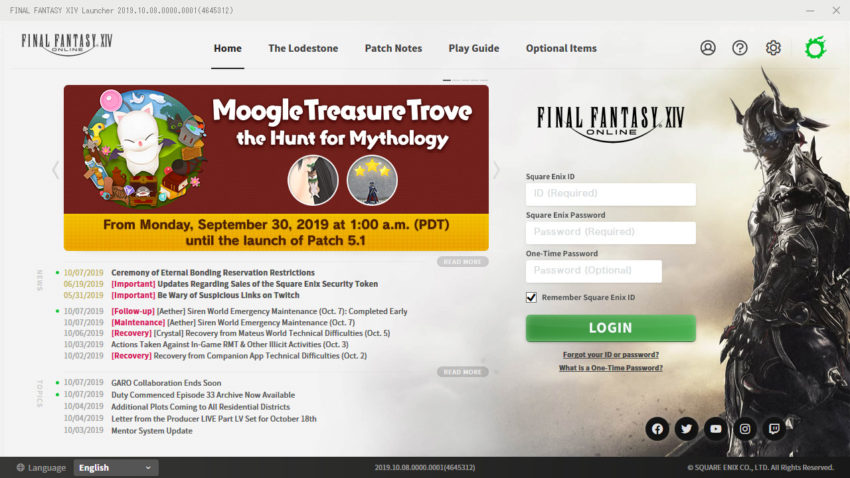
- #How to find out one time password square enix full
- #How to find out one time password square enix free
Million Arthur is a passable card battler that struggles to find purpose in VR. It also doesn’t help that every card is represented by a leery drawing of a girl par for the course in this genre but all the more uncomfortable in VR. You get a sense that the game is overselling everything’s worth to you in order to incentivize buying yet more flashy, exciting cards that in reality don’t have much worth. IAPs infect the game in other ways, though, from the horrid exclamations that you just got a super rare card (which seemed to be pretty common to me) and the grading of your deck configurations, which starts off at an A rank and progresses into the triple S ranks. You get booster packs after every level (yes, even the many cutscenes), so you’ll have a regular supply of cards. It’s a particularly salty inclusion given the game already costs $39.99, but I will say I managed to fight my way through a good chunk of the game without having to buy anything. Million Arthur does include that most controversial of features: an in-app purchase (IAP) system. This being a card battler, collecting and customizing decks obviously plays a huge part in the progression. This isn’t a game that takes the platform and reshapes VR in its image it’s just a direct translation that serves little purpose. This can happen multiple times within a fight and it’s especially frustrating when you can pull off the first sequence perfectly but then an unlucky hand means you get destroyed the next time.
#How to find out one time password square enix full
The game also suffers from heavy scripting, in which you’ll get two rounds into a boss fight, be interrupted by a cutscene, and then start over again with everyone on full health. JRPGs were never a genre for the inpatient but their sluggishness is only emphasized when brought directly into VR. All it really results in is a lot of standing around, waiting for your turn to raise your weapon up and swipe it down to imitate carrying out a magical attack. It’s not an especially thrilling system, but it’s not bad, either.Īgain, though, none of this really benefits from the inclusion of VR.

#How to find out one time password square enix free
After that you’ll be free to chomp down on their health bar pretty steadily. Usually, battles will boil down to first attacking an enemy’s weapons to disarm them and remove their ability to use stronger attacks. Only commanding one character can sometimes make the combat overly simplistic, or conversely quite frustrating if you’re depending on a particular character to heal you and they decide to attack instead. Big hitting-cards will be locked out at the start of battles but become available later on. You only control one member of your four-person party (chosen at the start of battle), but you can see the cards the others have selected, and then choose similar attack types to theirs to chain attacks. Getting to grips with the card battling is simple enough enemies have a particular element type that means they’ll be resistant to some types of attacks and weaker to others. It left me asking of all the games Square could have ported to VR, why this one? While the game looks nice overall, it’s all thanks to the original mobile release nothing here is really unique to the headset. Environmental design, meanwhile, is bland.

That goes for the enemies too, the larger of which really tower over you with awe. Visually the game’s character models are striking, and the anime art style really pops inside your headset.

Again, they’re lifted from the mobile game and the 3D assets seem to have been cleaned up just a bit. What was the point of even bringing it to the Vive in the first place? Fortunately, though, cutscenes can be skipped, though all the text is in Japanese so even story sequences in the 3D world use subtitles, which just doesn’t work well in VR.īattles themselves do fare a little better, even if they still lack purpose in VR. For VR, it’s an unforgivable sin to be asked to spend as much as 40 minutes reading dialogue boxes on a 2D screen before transitioning into a 10-minute battle. In fact the game’s cutscenes have been directly lifted from the smartphone game, appearing on a virtual screen in which characters deliver reams and reams of text so much so you’ll be doing more reading than you will playing. The story, for example, is characteristically nonsensical but lacks the iconic characters or cinematic delivery to justify it. Simply put, the many of the hallmarks you’d expect of a Square Enix game just aren’t here. In fairness, this isn’t a straight up JRPG it’s a turn-based card battler that began life on mobile and has transitioned to VR somewhat awkwardly.


 0 kommentar(er)
0 kommentar(er)
